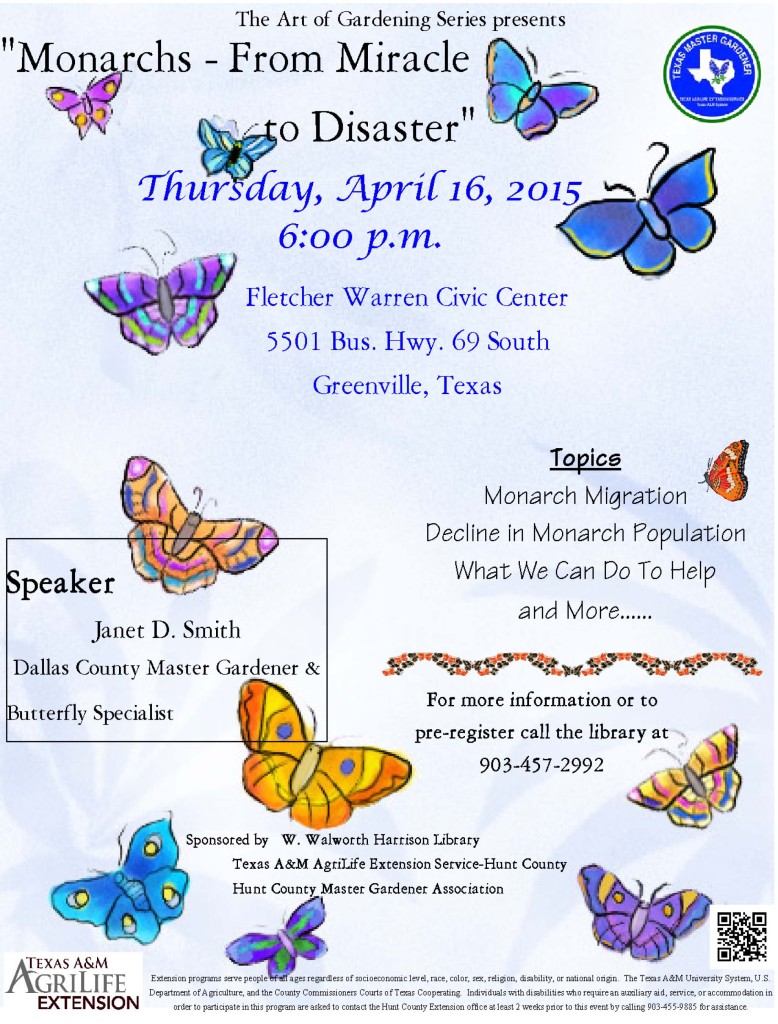Monarch Butterflies by Byron Chitwood, Master Gardener.
Monarch Butterflies reach our area in early to mid spring. Surprisingly some of these butterflies overwintered in the Mariposa Monarca Biosphere in Mexico. Some of the later spring migration that you witness may be the offspring of earlier ones that migrated from Mexico and reproduced along the way. There are several other mass migrations of Monarchs, some of which are the ones west of the Rockies and others that overwinter in Florida. The ones that we see and are interested in are the ones that are migrating east of the Rockies and through the Texas route. Their life cycle is fascinating and this article will briefly describe it.
In the northern migration, the females mate along the way. They can lay from 200-1,000 eggs. These eggs are then laid on the underside of a milkweed leaf. Only one egg is deposited per leaf. After the female has laid her eggs, she dies. Males die after they have mated up to fifteen times. The eggs hatch after 3 to 8 days and the larva begin feeding on the milkweed leaf. Apparently, milkweed leaves are the only food the larva eats during their caterpillar stage of life. During the caterpillar stage, the larva goes through five stages. At the end of each stage, the larva molts or sheds its outer skin and a larger caterpillar emerges. At the end of the fifth stage, the caterpillar spins a silk cocoon and hangs upside down from the milkweed host plant until it morphs and emerges as a butterfly. The young butterfly that has emerged waits until its wings have dried and then it flies off and heads north until she reaches sexual maturity in 3 to eight days at which time she mates and the life cycle begins all over again. This life cycle continues among her following generations four or five times until these later generations reach their northern most part of the migration in southern Canada.
There are theories on how they know where to go. My guess is that they follow the milkweed route as the weeds mature going from south to north in the spring and then north to south in the fall. The milk weeds are the key to their survival. As the larva consumes the leaves of the milkweed plant, they ingest a poison from the plant’s leaves that protects them throughout their life cycle against predators. Without the milkweed plant, there would be no monarch butterflies. Soy beans have become a huge cash crop for farmers. The farmers and seed producers have determined that weeds in soy bean fields compete with the soy bean plants for water, nutrients from the soil and direct sunlight. Soy bean genes have been manipulated (GMO) such that soy bean plants are Roundup® resistant. If these GMO seeds are planted, a field can be sprayed with Roundup® to kill the weeds and not adversely affect the soy bean plants.
I am not against using GMO (genetically modified organism) seeds. We have a whole world out there to feed and GMO plants have increased yields dramatically where used. Our mission is to plant Monarch Butterfly Way Stations along the butterfly’s migration. Any and everybody can plant a few milkweed seeds in a small garden spot. It is the Monarch’s job to sniff out these delicious and poisonous weeds to insure their survival. Hunt County Master Gardeners have such a plot in our Heritage Garden and we have many Monarchs visit for a tasty meal and to deposit a few eggs.
